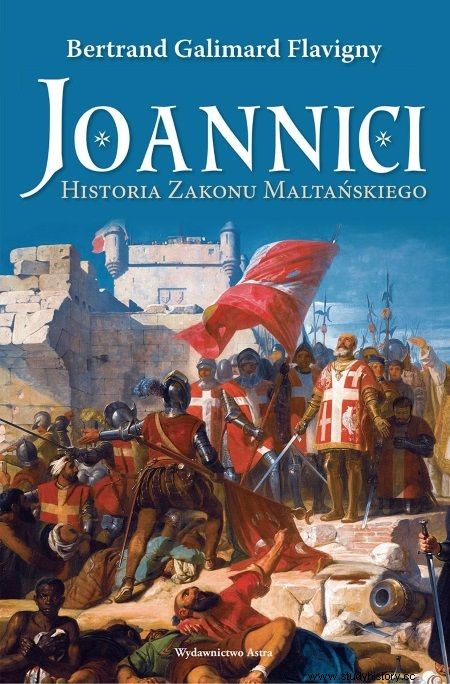Contrary to what Hollywood is trying to squeeze us in, pirates are not only the Caribbean and a barrel of rum drunk on a white beach. Not far away, in our European and North African backyards, bloody fights took place at sea, led by ... monks armed to the teeth.
The Mediterranean Sea, surrounded by lands belonging to three continents, has for centuries been a place where the influence of great empires met. Each of them wanted to take control of the fortunes of maritime trade in order to get as much as possible for themselves. When, after the fall of the Kingdom of Jerusalem in 1291, the Knightly Order of Hospitallers of Saint John, commonly known as the Knights Hospitaller, first settled in Cyprus, then Rhodes and Malta, it found itself in the middle of a fierce battle. And this is the fight that is being waged at sea.
The beginnings of the monastic fleet were very modest. While still in Palestine, as Bertrand Galimard Flavigny writes in his book Joannici. History of the Order of Malta ” , Hospitallers had several small units that convoyed pilgrims from France. After moving the headquarters of the Order from the Holy Land, the Knights Hospitaller began to expand their fleet to be ready to capture Jerusalem. In 1300, one of the dignitaries of the congregation was awarded the title of grand admiral, and in 1306 the pope gave permission for knights to arm their ships.
Knights switch from horses to ships
As Flavigny points out, creating a strong and independent fleet was a long process. Successive great masters of the order added building blocks important for its establishment and maintenance, building fortifications and ordering units. At the same time, the popes pressed the Knights Hospitaller to fight the pirates who attacked the Mediterranean islands and kidnapped Christians into slavery. It is worth noting that the then pirates were not a gang of ragged men attacking random units. The ships were commanded by experienced admirals who had large flotillas and the facilities in the form of entire islands or coastal strips.

A fleet of Hospitallers with characteristic flags in the colors of the monks' coats.
In a book on the pirates of the Mediterranean, Molly Green explains that piracy and piracy were practiced all over the body of water. The hostility between the different groups was further fueled by religious differences that skillful players were able to exploit for their own benefit. Joannites, as a knightly order originating from the crusades, found themselves perfectly in this situation. They turned their ships against Muslims. At least in the first moment. Galimard Flavigny also writes about it. Hospitaller ships:
(…) often returned with considerable loot from unfaithful corsairs who traversed these waters to kidnap pilgrims. These loot greatly increased the contents of the Order's armory. Since then, [...] the Order's flag has come to be respected. It also helped to maintain the courage of the knights and to train the young for war and sailing. (B.G. Flavigny "Joannites. History of the Order of Malta" )
Corsairs parading with crosses
The glorious struggle against dissenters, however, was not enough to meet the financial needs of the congregation. Gradually, the Knights Hospitaller themselves turned into ruthless pirates. As John Reeve Carpenter writes in his book "Pirates. Scourge of the Seas ”:
The Order of Malta launched pirate raids targeting coastal Berber settlements and harassing Muslim merchant ships. They also raided Venetian ships (causing the Pope's wrath) because the Venetians were at peace with the Ottoman Empire. Everything that they managed to plunder, they took to the headquarters of the order. By the end of the 1650s, they were generally viewed as being little different from pirates, and the Church despised them. One Venetian official called them "corsairs parading with crosses".
The order's apologists are discreetly silent about how knights in the aforementioned scarlet cloaks with a white cross fought at sea. First of all, they tried not to sink the enemy ship, but to seize it entirely as loot. When they entered its deck, they dealt quickly and bloodily with the crew. As Jörg-Dieter Brandes writes in his book "Christ's Corsairs", whoever came out of this skirmish alive ended up in the hands of the enemy and immediately became a slave-rowing machine, replacing the then released Christian slave oarsman from the unbelievers' ship . If Christians who had converted to Islam were among the crew members (for whatever reason), the monks immediately hung them on a flagpole.

Muslims repeatedly tried to wipe the Knights off the face of the earth, but the knights managed to defend their position. Only the four-month siege of Malta in 1565 brought an end to the heyday of monastic piracy. It is true that thanks to reinforcements from Spain it was possible to save the seat of the Hospitallers, but the Knights Hospitaller did not return to their former glory.
As John Reeve Carpenter states, the order operated in the Mediterranean for the next 200 years, until Napoleon conquered Malta in 1798. The Emperor of the French dissolved the Catholic Church and the institutions of the order on the island, and then plundered its property to finance an expedition to Egypt. Interestingly, the negotiations between Napoleon and the hospitallers were mediated by a certain Déodat Gratet de Dolomieu, called by his biographer a bachelor-geologist. As a young man, he began his career among the Knights Hospitaller, but he killed one of his brothers in a duel, for which he was imprisoned. Bertrand Galimard Flavigny describes in the book “Joannici. History of the Order of Malta ” that de Dolomieu decided to go with the French, not even knowing that part of the trip would be the capture of Malta ...
Buy with a discount on Empik.com:

